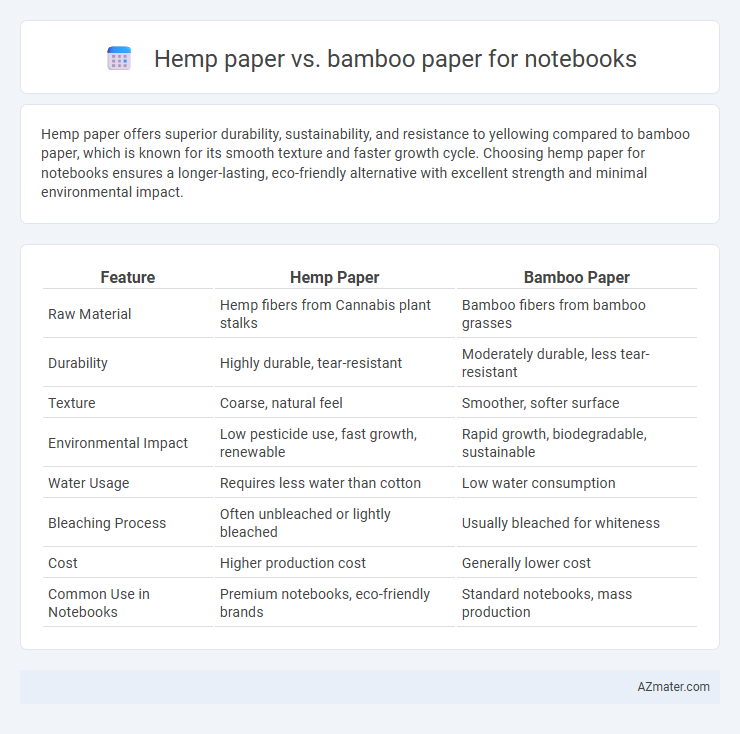Hemp paper offers superior durability, sustainability, and resistance to yellowing compared to bamboo paper, which is known for its smooth texture and faster growth cycle. Choosing hemp paper for notebooks ensures a longer-lasting, eco-friendly alternative with excellent strength and minimal environmental impact.
Table of Comparison
| Feature | Hemp Paper | Bamboo Paper |
|---|---|---|
| Raw Material | Hemp fibers from Cannabis plant stalks | Bamboo fibers from bamboo grasses |
| Durability | Highly durable, tear-resistant | Moderately durable, less tear-resistant |
| Texture | Coarse, natural feel | Smoother, softer surface |
| Environmental Impact | Low pesticide use, fast growth, renewable | Rapid growth, biodegradable, sustainable |
| Water Usage | Requires less water than cotton | Low water consumption |
| Bleaching Process | Often unbleached or lightly bleached | Usually bleached for whiteness |
| Cost | Higher production cost | Generally lower cost |
| Common Use in Notebooks | Premium notebooks, eco-friendly brands | Standard notebooks, mass production |
Introduction to Sustainable Paper Alternatives
Hemp paper offers a sustainable alternative to traditional wood pulp paper due to its rapid growth cycle and high cellulose content, resulting in durable, eco-friendly notebooks with lower environmental impact. Bamboo paper, derived from fast-growing bamboo plants, provides a renewable resource that requires minimal water and pesticides, making it an excellent choice for sustainable notebook production. Both hemp and bamboo papers contribute to reducing deforestation and promoting environmentally responsible materials in the paper industry.
Overview of Hemp Paper
Hemp paper, made from the fibrous stalks of the hemp plant, offers superior durability and a longer lifespan compared to bamboo paper, making it an ideal choice for notebooks requiring resilience. It contains fewer chemicals and bleaches during production, resulting in a more eco-friendly and sustainable option with high tensile strength and natural resistance to yellowing. Hemp paper's coarse texture and heavier weight enhance writing experience, especially for artists and writers seeking durability without compromising environmental impact.
Overview of Bamboo Paper
Bamboo paper for notebooks is produced from the fast-growing bamboo plant, known for its sustainability and eco-friendly attributes, as it requires less water and pesticides compared to traditional wood pulp. This paper typically offers a smooth, durable texture with natural antibacterial properties, making it resistant to mold and odors. Bamboo paper's renewable nature and minimal environmental impact position it as a strong alternative to hemp paper in eco-conscious stationery markets.
Environmental Impact: Hemp vs Bamboo
Hemp paper produces significantly lower carbon emissions and requires 60-70% less water compared to bamboo paper, making it a more sustainable choice for notebooks. Bamboo grows rapidly but demands intensive chemical processing, which can lead to soil degradation and water pollution. In contrast, hemp thrives with minimal pesticides and regenerates soil health, offering a more eco-friendly footprint in notebook production.
Material Strength and Durability Comparison
Hemp paper offers superior tensile strength and durability compared to bamboo paper due to its longer fibers, making it more resistant to tearing and wear in notebooks. Bamboo paper, while eco-friendly and smooth, typically features shorter fibers that result in a softer texture but less overall resilience. For notebooks requiring long-lasting pages with minimal degradation, hemp paper provides a more robust material choice.
Texture and Writing Experience
Hemp paper offers a coarse texture providing excellent ink absorption and minimal bleed-through, ideal for fountain pens and markers. Bamboo paper has a smoother surface, creating a silky feel that enhances crisp pen strokes and reduces friction, perfect for detailed handwriting or sketching. Both papers offer durable, eco-friendly options, but choice depends on preferred tactile feedback and writing instruments.
Production Processes and Resource Efficiency
Hemp paper production involves retting, pulping, and bleaching hemp fibers, resulting in a durable and eco-friendly material with a shorter growing cycle of about 3-4 months, requiring less water and fewer pesticides compared to traditional wood pulp. Bamboo paper is made by mechanically and chemically processing bamboo stalks, which grow rapidly in 3-5 years and require minimal fertilizers, offering high tensile strength and natural antifungal properties. Resource efficiency favors hemp due to its lower water consumption and faster harvest cycle, while bamboo's rapid renewability and high biomass yield provide a sustainable alternative for notebook paper production.
Cost and Market Availability
Hemp paper generally costs more than bamboo paper due to the labor-intensive cultivation and processing methods, but it offers higher durability and eco-friendliness. Bamboo paper benefits from faster crop regeneration and wider market availability, making it a more affordable and accessible choice globally. Both options present sustainable alternatives, though bamboo paper dominates in cost-effectiveness and distribution for notebook production.
Eco-Friendly Benefits for Notebook Users
Hemp paper offers superior eco-friendly benefits for notebook users due to its rapid growth cycle and minimal pesticide requirements, resulting in a lower environmental footprint compared to traditional tree-based papers. Bamboo paper also ranks high in sustainability, as bamboo regenerates quickly and requires less water, making it a renewable resource that reduces deforestation concerns. Both hemp and bamboo papers provide biodegradable and recyclable options, promoting a greener choice for environmentally conscious notebook users seeking to reduce waste and support sustainable forestry practices.
Conclusion: Choosing the Right Paper for Sustainable Notebooks
Hemp paper offers superior durability and biodegradability, making it an excellent choice for eco-conscious notebook users seeking long-lasting quality. Bamboo paper provides a fast-renewable resource with a smooth texture and is ideal for those prioritizing renewable materials and a soft writing experience. Both options contribute significantly to sustainability, but selecting between hemp and bamboo paper depends on whether strength or rapid renewability aligns better with personal environmental goals.

Infographic: Hemp paper vs Bamboo paper for Notebook
 azmater.com
azmater.com